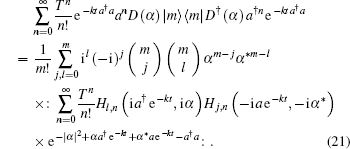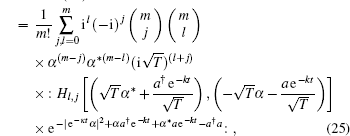Corresponding author. E-mail: xuxf@wxit.edu.cn
Project supported by the National Natural Science Foundation of China (Grant Nos. 11174114 and 11175113)and the Natural Science Foundation of Wuxi Institute of Technology of China (Grant No. 4013012931).
We propose a new optical field and show that such an optical field can be generated as an output of a displaced Fock state in an amplitude dissipative channel. We derive new generating function formulas and binomial formula involving two-variable Hermite polynomials to reach this result. The photon number average in this new optical field is
For a long time, the nature of light has been extensively studied by physicists. It has been a common sense that different optical fields may exhibit various properties of light. For instance, a coherent state of light is different from chaotic light, and the squeezed state of light displays some nonclassical properties, such as antibunching, squeezing, sub-Poisson statistics, etc. Thus, finding new optical fields provides us with a new opportunity to explore the nature of light. On the other hand, since most systems in the real world are immersed in a reservoir, studying optical fields' amplitude decay (dissipation in a lossy cavity) is related to quantum decoherence. A typical model for describing damping is displayed in the following master equation:[1– 4]
 |
where κ is the rate of decay, a† and a are the photon creation operator and the annihilation operator respectively, and [a, a† ] = 1. In this damping channel, a coherent field |α ⟩ ⟨ α | evolves into |α e − κ t⟩ , where |α ⟩ = D(α )|0⟩ , |0⟩ is the vacuum state, and D(α ) = exp [α a† − α * a] is the displacing operator. It then naturally challenges us how does an initial displaced Fock state, whose density operator is D(α ) |m⟩ ⟨ m|D† (α ) = ρ 0, behave in the amplitude dissipative channel? Will a new optical field emerge in this decaying process? The displaced Fock state can be generated when a harmonic oscillator, initially in a Fock state 
 |
where ∷ denotes normal ordering, T = 1 − e− 2kt, and Lm is the m– th Laguerre polynomial, |α e− κ t⟩ is a coherent state, |α e– κ t⟩ = exp[− |α |2e− 2κ t + α e– κ ta† ] |0⟩ . Equation (2) is the time evolution law of displaced Fock state in a dissipative channel.
This paper is arranged as follows. In Section 2 we briefly review how the master equation can be solved concisely by working in the thermo entangled state representation. In Sections 3 and 4, for examining how the displaced Fock state evolves in this channel, we use new generating function formulas and binomial formula involving two-variable Hermite polynomials to derive the normally ordered Laguerre polynomial weighted coherent state ρ (t), which is a mixed state. In Section 5 the average photon number 
In order to directly solve Eq.(1), we take a convenient approach in which the thermo entangled state[5– 7]
 |
is employed, where ã † is a fictitious mode accompanying the real photon mode a† , 

 |
Acting both sides of Eq.(1) on the state |η = 0⟩ ≡ |I⟩ , and denoting |ρ ⟩ = |I⟩ , we have
 |
In this way, the operator (1) becomes a Schrö dinger equation of state vector |ρ ⟩ , and the formal solution of Eq. (5) is
 |
where |ρ 0⟩ ≡ ρ 0 |I⟩ , and ρ 0 is the initial density operator which only includes real operators. Noting that the operators in Eq. (6) obey the following commutative relation:
 |
and using the operator identity
 |
which is valid for [A, B] = τ B, we have
 |
where
 |
Then substituting Eq. (9) into Eq. (6) and using Eq. (4) yield
 |
which leads to the solution in operator-sum representation[8]
 |
Now using
 |
 |
and the operator identity
 |
where Hl, n is the two-variable Hermite polynomial whose definition is given by[9– 11]
 |
or
 |
we have
 |
It then follows from e− kta† a a† ekta† a = a† e− kt that
 |
Substituting Eq. (19) into Eq. (12) and using
 |
as well as |0⟩ ⟨ 0| = : e− a† a: , we have
 |
Therefore, we need to derive some new summation formulas about Hermite polynomial Hj, n for further calculation.
Now we prove the following generating function formulas involving two-variable Hermite polynomials
 |
In fact, using
 |
after straightforward calculation, we have
 |
Therefore,
RHS(21)
 |
then we still need a new binomial summation formula which involves Hl, j.
We propose the following new binomial summation formula involving Hl, j:
 |
Proof Noticing
 |
where ∶ ∶ denotes anti-normal ordering within the symbol ∶ ∶ the operator a and a† are permuted. Comparing the two sides of Eq. (27) we obtain the antinormally ordered form of a† nam
 |
Now using Eq. (28) we consider
 |
Multiplying the two sides of Eq. (29) by 
 |
so
 |
This verifies the correctness of Eq. (26), or we have
 |
which is a new binomial theorem involving a two-variable Hermite polynomial. Then the summation in Eq. (25) leads to
 |
where in the last step we used
 |
and Ln(x) is the Laguerre polynomial
 |
Equation (33) represents a new optical field (a Laguerre-polynomial-weighted mixed state) generated as an output of the displaced Fock state in amplitude dissipative channel, so this damping process manifestly embodies quantum decoherence.
For this new density operator, we must check if Tr[ρ (t) = 1. In fact, using Eq. (33) and the coherent state representation we have
 |
where we have used the integration formula
 |
Now we examine Eq. (33) in two special cases. When m = 0, Lm= 0(x) = 1, so equation (33) reduces to : |α e− κ t⟩ ⟨ α e− κ t| : = |α e− κ t⟩ ⟨ α e− κ t|, which represents the dissipation of an initial coherent state. On the other hand, when α = 0, from Eq. (35) we obtain
 |
which represents a binomial state. This explains that when the initial state is a number state |m⟩ ⟨ m|, it will evolve into a binomial state in the dissipative channel.
Then we evaluate the photon number expectation in the new optical field. Using Eqs. (33) and (36) as well as the integration formula
 |
we can obtain
 |
which exhibits exponential damping with time. As many properties of a quantum optical field can be judged by photocounting, we can explore this new Laguerre-polynomial-weighted coherent state in this manner.
In summary, for the first time we have obtained a new optical field which is described by

The time evolution law of displaced Fock state in a thermo reservoir is thus revealed. The photon number average in this field is 
| 1. |
|
| 2. |
|
| 3. |
|
| 4. |
|
| 5. |
|
| 6. |
|
| 7. |
|
| 8. |
|
| 9. |
|
| 10. |
|
| 11. |
|

